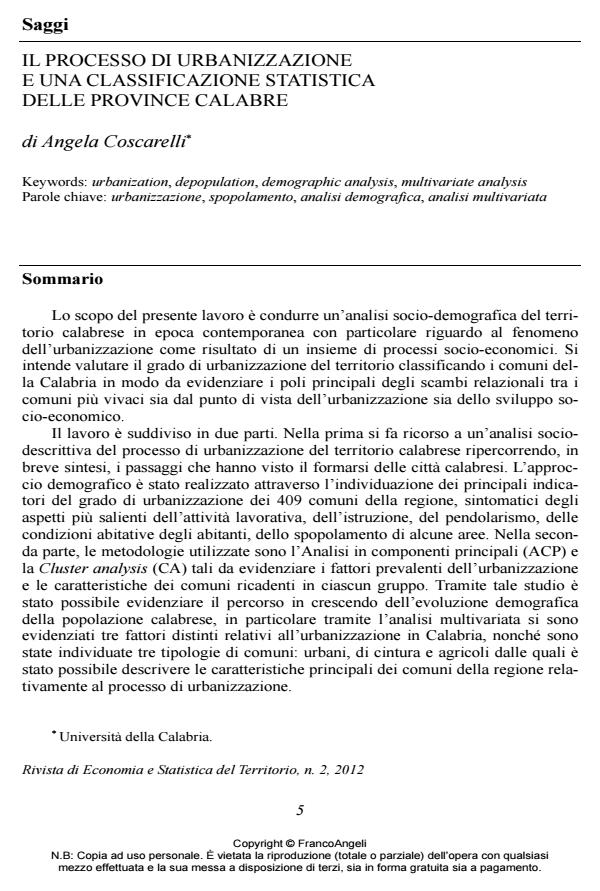The urbanization process and a statistical classification of the districts of Calabria Objectives
Journal title RIVISTA DI ECONOMIA E STATISTICA DEL TERRITORIO
Author/s Angela Coscarelli
Publishing Year 2012 Issue 2012/2 Language Italian
Pages 29 P. 5-33 File size 741 KB
DOI 10.3280/REST2012-002001
DOI is like a bar code for intellectual property: to have more infomation
click here
Below, you can see the article first page
If you want to buy this article in PDF format, you can do it, following the instructions to buy download credits

FrancoAngeli is member of Publishers International Linking Association, Inc (PILA), a not-for-profit association which run the CrossRef service enabling links to and from online scholarly content.
The purpose of this study is to conduct a socio-demographic analysis of Calabria in the contemporary era with particular attention to the phenomenon of urbanization as a result of a set of socio-economic processes. The aim is to assess the degree of urbanization of the area classifying the municipalities of Calabria in order to highlight the main poles of relational exchanges between the liveliest both in terms of urbanization and socio-economic development. Methods and Results The work is divided into two parts. The first one makes use of a sociodescriptive analysis of the process of urbanization in Calabria by a brief summary retracing the steps that have seen the emergence of cities in Calabria. The population approach has been realized through the identification of the main indicators of the degree of urbanization of the 409 municipalities in the region that are symptomatic of the most important aspects of employment, education, commuting, housing conditions of the inhabitants, the depopulation of some areas. In the second part, the methodologies used are Principal Component Analysis (ACP) and the Cluster Analysis (CA) such as to highlight the prevailing factors of urbanization and the characteristics of the municipalities within each group. Through this study it was possible to highlight the growing path in the evolution of the population of Calabria, in particular, through the multivariate analysis, there was evidence of three separate factors related to urbanization in Calabria, and were identified three types of municipalities: urban, belt and agricultural from which it was possible to describe the main characteristics of municipalities in the region regarding the process of urbanization. Conclusions The study highlights the existence of greater regional urbanization areas of population, represented by areas of intense urbanization. This is how a picture of a region in which there are stable urban areas and rural areas in gradual decline. With regard to the latter it notes in the map of the region a total of 256 municipalities, i.e. 62.6% which are classified as rural with a population of about 723.000 inhabitants, approximately 36%. Municipalities belt, by contrast, are those having the highest increases in population, as well as revealing potential areas of further urban development. Through this study can offer insights to the regional planners, and to pay attention to the potential growth of different urban areas considered and their peculiar strategic role in the process of regional development, taking account also of the macro-spatial context in which they insist.
Keywords: Urbanization, depopulation, demographic analysis, multivariate analysis
Jel codes: J, R11, C
Angela Coscarelli, Il processo di urbanizzazione e una classificazione statistica delle province calabre in "RIVISTA DI ECONOMIA E STATISTICA DEL TERRITORIO" 2/2012, pp 5-33, DOI: 10.3280/REST2012-002001